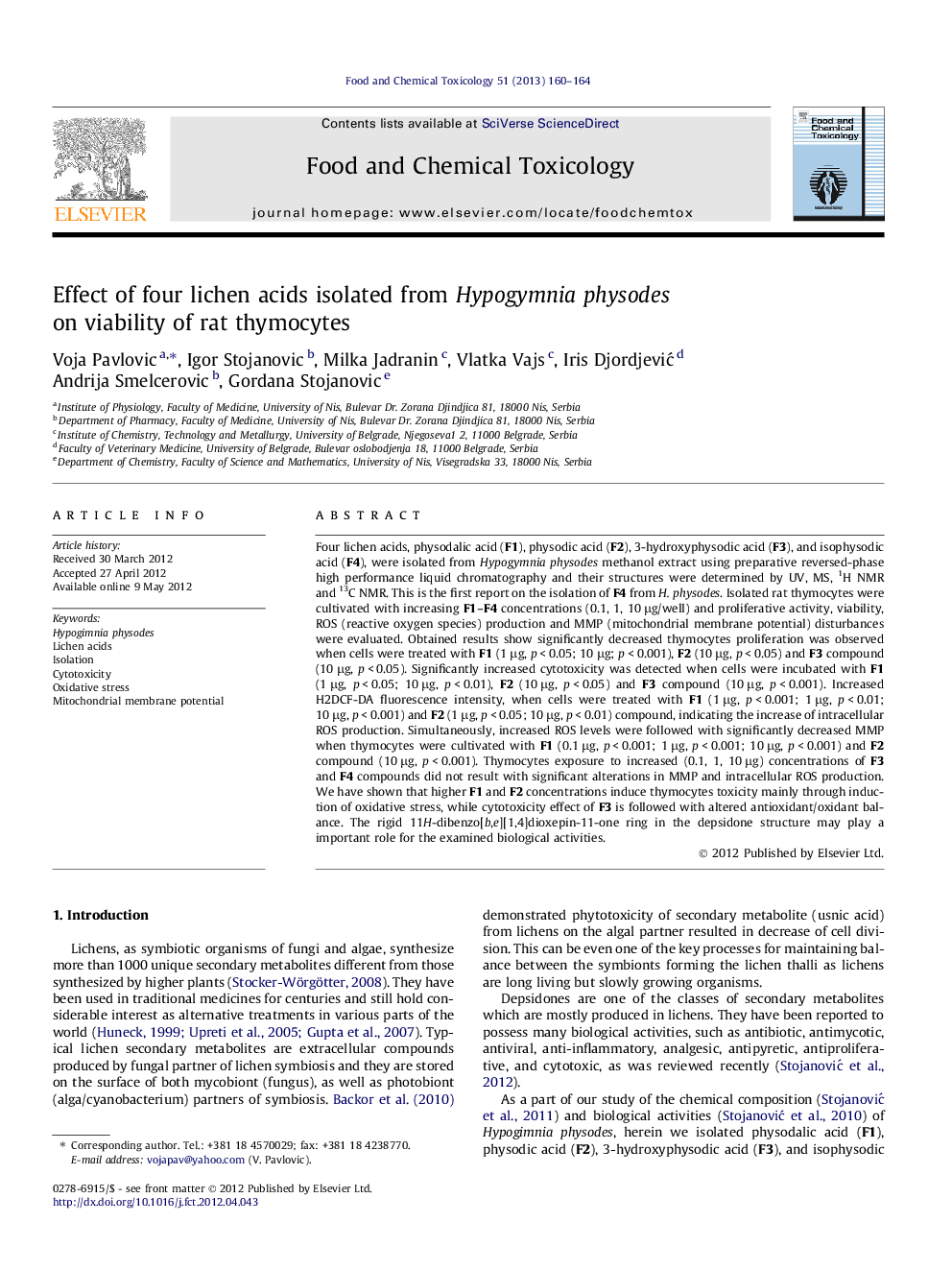| کد مقاله | کد نشریه | سال انتشار | مقاله انگلیسی | نسخه تمام متن |
|---|---|---|---|---|
| 5851978 | 1561793 | 2013 | 5 صفحه PDF | دانلود رایگان |
عنوان انگلیسی مقاله ISI
Effect of four lichen acids isolated from Hypogymnia physodes on viability of rat thymocytes
ترجمه فارسی عنوان
اثر چهار اسید لیشن جدا شده از فیزیک هیپوگیمنی بر روی حیوانات تیموشیت موش صحرایی
دانلود مقاله + سفارش ترجمه
دانلود مقاله ISI انگلیسی
رایگان برای ایرانیان
کلمات کلیدی
موضوعات مرتبط
علوم زیستی و بیوفناوری
علوم کشاورزی و بیولوژیک
دانش تغذیه
چکیده انگلیسی
Four lichen acids, physodalic acid (F1), physodic acid (F2), 3-hydroxyphysodic acid (F3), and isophysodic acid (F4), were isolated from Hypogymnia physodes methanol extract using preparative reversed-phase high performance liquid chromatography and their structures were determined by UV, MS, 1H NMR and 13C NMR. This is the first report on the isolation of F4 from H. physodes. Isolated rat thymocytes were cultivated with increasing F1-F4 concentrations (0.1, 1, 10 μg/well) and proliferative activity, viability, ROS (reactive oxygen species) production and MMP (mitochondrial membrane potential) disturbances were evaluated. Obtained results show significantly decreased thymocytes proliferation was observed when cells were treated with F1 (1 μg, p < 0.05; 10 μg; p < 0.001), F2 (10 μg, p < 0.05) and F3 compound (10 μg, p < 0.05). Significantly increased cytotoxicity was detected when cells were incubated with F1 (1 μg, p < 0.05; 10 μg, p < 0.01), F2 (10 μg, p < 0.05) and F3 compound (10 μg, p < 0.001). Increased H2DCF-DA fluorescence intensity, when cells were treated with F1 (1 μg, p < 0.001; 1 μg, p < 0.01; 10 μg, p < 0.001) and F2 (1 μg, p < 0.05; 10 μg, p < 0.01) compound, indicating the increase of intracellular ROS production. Simultaneously, increased ROS levels were followed with significantly decreased MMP when thymocytes were cultivated with F1 (0.1 μg, p < 0.001; 1 μg, p < 0.001; 10 μg, p < 0.001) and F2 compound (10 μg, p < 0.001). Thymocytes exposure to increased (0.1, 1, 10 μg) concentrations of F3 and F4 compounds did not result with significant alterations in MMP and intracellular ROS production. We have shown that higher F1 and F2 concentrations induce thymocytes toxicity mainly through induction of oxidative stress, while cytotoxicity effect of F3 is followed with altered antioxidant/oxidant balance. The rigid 11H-dibenzo[b,e][1,4]dioxepin-11-one ring in the depsidone structure may play a important role for the examined biological activities.
ناشر
Database: Elsevier - ScienceDirect (ساینس دایرکت)
Journal: Food and Chemical Toxicology - Volume 51, January 2013, Pages 160-164
Journal: Food and Chemical Toxicology - Volume 51, January 2013, Pages 160-164
نویسندگان
Voja Pavlovic, Igor Stojanovic, Milka Jadranin, Vlatka Vajs, Iris DjordjeviÄ, Andrija Smelcerovic, Gordana Stojanovic,
